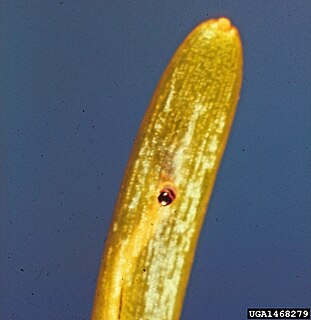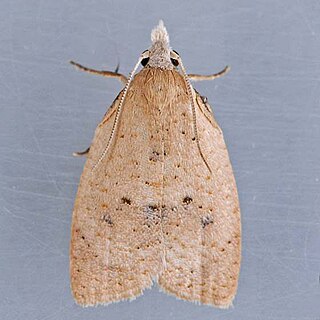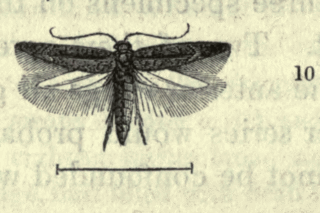Keiferia is a genus of moths in the family Gelechiidae.
Geshna is a monotypic moth genus of the family Crambidae described by Harrison Gray Dyar Jr. in 1906. It contains only one species, Geshna cannalis, the lesser canna leafroller, described by Altus Lacy Quaintance in 1898. It is found in North America, where it has been recorded from Florida, Mississippi, South Carolina, North Carolina and Tennessee. It has also been recorded from Costa Rica and Cuba.
Coleotechnites ponderosae, the ponderosa pine needleminer, is a moth of the family Gelechiidae. It is found in the United States, where it has been recorded from Colorado.

Epinotia meritana, the white-fir needle miner, is a moth of the family Tortricidae. It is found in the western United States, including Utah, New Mexico and Arizona.

Gretchena bolliana, the pecan bud moth or gray-flanked gretchena moth, is a moth of the family Tortricidae. It is found in the United States from South Carolina to Florida and west to Texas, Arizona and New Mexico.
Fundella pellucens, the Caribbean pod borer, is a species of snout moth in the genus Fundella. It was described by Zeller in 1848.
Sparganothoides machimiana is a species of moth of the family Tortricidae described by William Barnes and August Busck in 1920. It is found from the mountains and woodlands of Arizona, Colorado and New Mexico in the United States south to Durango in Mexico. The habitat consists of mixed forests and oak woodlands.

Sparganothoides lentiginosana, the lentiginos moth, is a species of moth of the family Tortricidae. It is found in the United States from Maryland to Florida, west to Arkansas, Texas and Oklahoma, ranging south to Mexico in Tamaulipas and Veracruz. It is found in a wide range of habitats, ranging from urban areas to mixed pine-deciduous woodlands at low elevations.

Platynota flavedana, the black-shaded platynota moth, is a species of moth of the family Tortricidae. It is found in the United States from Minnesota to Maine, south to North Carolina and west to Arizona.
Elachista praelineata is a moth of the family Elachistidae. It is found in the United States, where it has been recorded from Ohio. The habitat consists of dry hillside woods.

Syndemis afflictana, the gray leafroller, dead leaf roller or black-and-gray banded leafroller, is a species of moth of the family Tortricidae. It is found in North America, where it has been recorded from southern Canada and the northern United States. In the west, the range extends south in the mountains to California. The species is also present in Florida. The habitat consists of coniferous forests.
Rhectocraspeda periusalis, the eggplant webworm moth, is a moth in the family Crambidae. It was described by Francis Walker in 1859. It is found in the West Indies and from the United States, where it has been recorded from Florida, North Carolina, Ohio, Oklahoma, South Carolina and Tennessee, south through Mexico and Central America to South America, including Ecuador, Brazil, Guyana, Trinidad and Tobago and Suriname.

Frechinia helianthiales is a moth in the family Crambidae. It was described by Murtfeldt in 1897. It is found in North America, where it has been recorded from Arizona, Illinois, Manitoba, Missouri and Oklahoma, south to Mexico.

Aroga trialbamaculella, the red-striped fireworm moth, is a moth of the family Gelechiidae. It is found in the United States, where it has been recorded from Maine to Florida and from Illinois to Texas.
Keiferia altisolani is a moth in the family Gelechiidae. It was described by Kieffer in 1937. It is found in North America, where it has been recorded from California.
Keiferia elmorei is a moth in the family Gelechiidae. It was described by Keifer in 1936. It is found in North America, where it has been recorded from California.
Keiferia inconspicuella is a moth in the family Gelechiidae. It was described by Murtfeldt in 1883. It is found in North America, where it has been recorded from the south-eastern and mid-western United States, north to New Jersey and Iowa and west to Nebraska and Texas.

Scrobipalpa instabilella, the saltern groundling, is a moth in the family Gelechiidae. It was described by John William Douglas in 1846. It is found in on the Canary Islands, in Algeria, Ireland, Great Britain, Portugal, Spain, France, Belgium, the Netherlands, Germany, Denmark, Italy, Sardinia, Sicily, Greece, Cyprus and Palestine. It is also present in the United States, where it has been recorded from California.
Symmetrischema capsica, the pepper flowerbud moth, is a moth in the family Gelechiidae. It was described by John David Bradley and Dalibor F. Povolný in 1965. It is found Mexico, the West Indies, the Caribbean and the south-eastern United States, where it has been recorded Florida and Texas.
Syncopacma crotolariella is a moth of the family Gelechiidae. It was described by August Busck in 1900. It is found in North America, where it has been recorded from Florida.







